Identifying Converter Components: 6 Key Features to Understand in Ford E4OD, 4R100 & 5R110W
Ed Lee
Whether you are searching through a core pile or looking for a specific part to complete a rebuild, sorting out the various identifying features of Ford E4OD, 4R100 and 5R110W converters can drive you crazy. A six-stud version of each converter that happens to have the same K factor (impeller blade angle) will look almost identical. If you have not educated yourself on the subtle contour differences where the impellers mate to the impeller hubs, or cannot recognize the .200" difference in the relationship of the pilot to mounting pad difference in the 5R110W compared to the E4OD and 4R100, you can become easily frustrated. The following are part-by-part differences, as well as some hints for identifying each one.
Covers
The early-style E4OD covers (first generation) had round mounting pads at the base of the studs (Figure 1). The round pad converter covers were prone to crack and leak around the base of the mounting stud.
| Figure 1: Failure-prone round mounting pads used on early-style E4OD converters. |
|---|
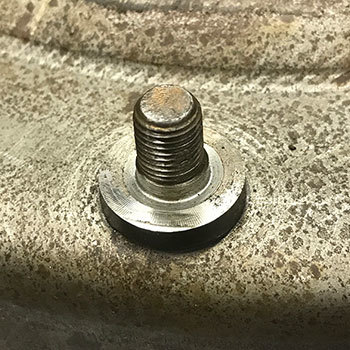
For this reason, most round-pad E4OD converters have already been removed from service. The improved replacement covers feature a mounting pad that looks like a round pad with a flat machined on the inboard and outboard sides (Figure 2).
| Figure 2: Improved mounting pad used on 4R100, 5R110W and late-style E4OD covers. |
|---|
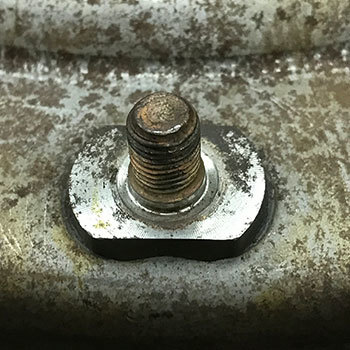
This improved pad solved the crack/leak problems on the E4ODs and is still used today on the 4R100 and 5R110W converters.
From the outside, the late-style E4OD and 4R100 covers look the same. But looking inside, you will see that the sides of the E4OD are smooth and the 4R100 are grobed to hold a clutch. For this reason, you can use a 4R100 cover to build an E4OD converter, but you can only use an E4OD cover to build a 4R100 converter if a single clutch is used. The 5R110 cover is also grobed on the inside, but cannot be substituted for either because of the shorter-pilot-to-mounting-pad relationship (Figure 3).
| Figure 3: The dimension from the mounting surface to the top of the pilot is shown. E4OD/4R100 covers will measure 1.000" and 5R110W covers will measure shorter at .800". |
|---|
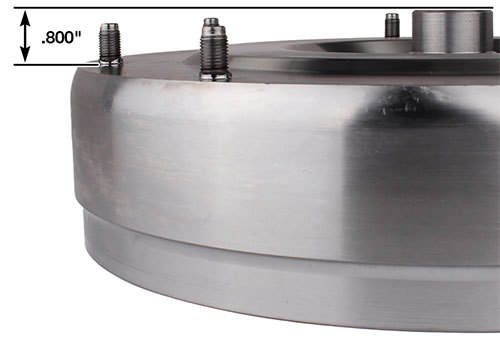
Turbines
The turbines for the E4OD, 4R100 and 5R110W converters look very similar and in many respects are identical: they are the same diameter and have the same number of vanes. The differences become noticeable when you look at where the turbines mate to the turbine hubs. The E4OD turbines have the same piloting bore diameter (2.765") as the C4, C5, C6 and AOD turbines. They also have the same rivet circle and use the same diameter rivet (.218"). The late-style E4OD turbines have a slight contour dip at the rivet surface (Figure 4), while the early-style turbines are nearly flat (Figure 5) but this does not seem to affect internal clearance.
| Figure 4: Countour Dip at Rivet Surface on Late-Style E4ODs |
|---|
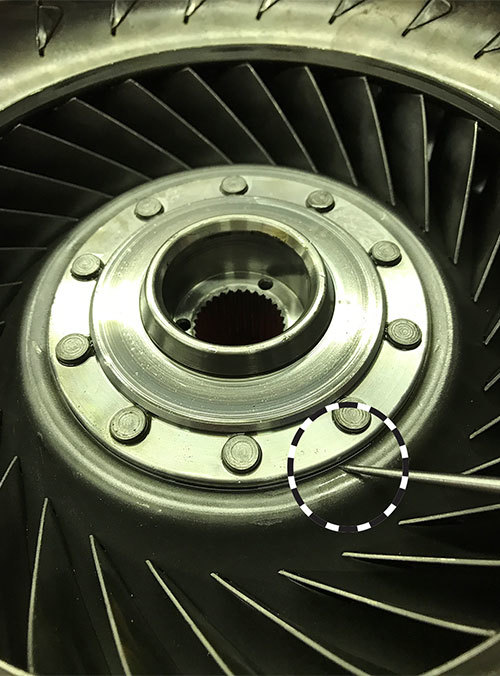
| Figure 5: Flat Rivet Surface on Early-Style E4ODs |
|---|

The 4R100 turbines use the same rivet circle and rivet diameter as the E4OD turbines, but have a larger I.D. bore (2.955"). This is the piloting diameter for the turbine hub.
All of the 5R110W turbines have an I.D. that is about .015" smaller than the 4R100 turbine’s 2.940" I.D. The four- and six-stud versions of the 5R110W use the same rivet circle and rivet diameter as the 4R100 turbines. The eight-stud version of the 5R110W turbines move the rivet circle slightly outboard of the 4R100 rivet circle and use a rivet with about a .065" larger diameter. Ford may have been anticipating the larger rivet diameter when they made the I.D. bore .015" smaller.
In a side-by-side comparison, you will notice that the depth of the arch is slightly deeper on the 4R100 and 5R110W turbines than on the earlier turbines (Figures 6 and 7). The arch is created from where the oil enters the turbine to where the oil exits the turbine.
| Figure 6: Arch Depth on 4R100 Turbine |
|---|
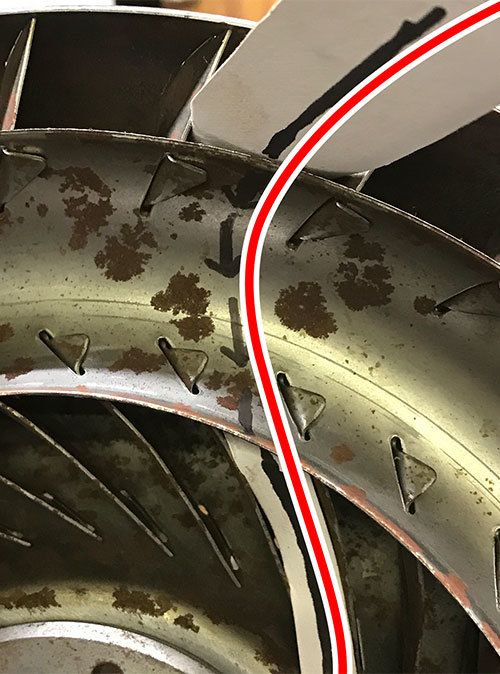
| Figure 7: Arch Depth on 5R110W Turbine |
|---|

This means that the oil will travel a greater distance through the turbine and will spend more time in the turbine giving more push in the direction of the rotation. This may explain why Ford assigns a 105 K factor to the low-stall E4OD converter and a 110 K factor to the low-stall 5R110W converter, even though both use the same stator and have the same vane angle in the impellers. The 4R100 and 5R110W turbines have vanes that are .005" thicker than the earlier turbines, and all 5R110W turbines are furnace-brazed. Remember this when retrofitting an earlier turbine. You may want to limit their use to low-output applications.
Turbine Hubs
All E4OD, 4R100 and 5R110W turbine hubs are different and need to be matched to their respective clutch assemblies.
Turbine Hubs to Turbine Rivets
All rivets, with the exception of the eight-stud 5R110W, are 2.18” in diameter and vary in length depending on turbine hub flange thickness and whether the application uses a retaining ring.
Stators
The E4OD, 4R100 and 5R110W stators are the most universal parts of these converters. All have the same design and function. If the stator caps and bearing assemblies are properly mated to the turbines and impellers, they will work.
| Figure 8: Universal stator will function in all E4OD, 4R100 and 5R110W converters if the correct stator caps and mating parts are used. |
|---|

Impellers
The E4OD, 4R100 and 5R110W impellers come in three vane angles. The high-stall impeller has a vane angle that looks like a left-handed salute. It has a 140 K factor and is primarily used on small block gas applications. There is no high-stall impeller used with the 5R110W converters.
The low-stall impellers have a vane angle that is almost straight up and down. In most other converters, this would be called a medium stall. The E4OD converters with the low-stall impellers have a 105 K factor. The 4R100 and the 5R110W converters with the low-stall impellers have a 110 K factor.
The extra-low-stall impeller has a vane angle that looks like a right-handed salute. The converters with the extra-low-stall impellers have a 95 K factor. Most 5R110W converters use an extra-low-stall impeller. Most customer complaints are the results of using an extra-low-stall impeller for a low-stall application. This results in an off idle hesitation in a gas model or a turbo lag in a diesel model.
There are many generations of bearings and wear plates used between the stator and impeller and most are specific to a given impeller hub. Start by making certain that the stator cap and bearing are still available (some have been discontinued). Then match the impeller with the desired K factor to your bearing and stator assembly. Remember that you can always replace the impeller hub to come up with the proper mating part.
All E4OD, 4R100 and 5R110W converters have the same diameter pilot, bolt circle at the flex plate, overall height, 31 input splines (same as a C6) and stator splines. The clutch assembly will determine what cover and turbine hub you use. The desired K factor will determine what impeller to use. Most mismatches in parts will show up as too much or too little internal clearance, or too tall or too short in overall height.
Ed Lee is a Sonnax technical specialist who writes on issues of interest to torque converter rebuilders and member of the Sonnax TASC Force (Technical Automotive Specialties Committee), a group of recognized industry technical specialists, transmission rebuilders and Sonnax Industries Inc. technicians.
Related Units
While Sonnax makes every effort to ensure the accuracy of technical articles at time of publication, we assume no liability for inaccuracies or for information which may become outdated or obsolete over time.